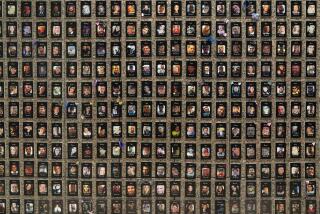PERSPECTIVE ON FAMILY WELFARE : Children Lash Out Against Neglect : What else do we expect when we offer ‘values’ instead of supportive programs to a generation growing up in chaos?
Thoreau observed that the mass of men lead lives of quiet desperation. Today, more and more of our children are leading such lives as well.
The stories I hear from those on the front lines of services for children--people in mental health, social work, foster care and juvenile justice--add up to a horrifying saga of abuse, neglect, violence and disruption. When I began my practice in child and adolescent psychiatry 25 years ago, I encountered my share of troubled youngsters, rebellious adolescents and families in crisis. But that was nothing compared to the number, depth and range of problems that today’s children face.
Legions of children in this country have had their early development shaped by such chaos that their most consistent emotional response to the world is rage. Their anger is an understandable reaction to the conditions in which they live--conditions that undermine the emotional attachment, security, predictability and nurturing necessary to develop empathy for others, a sense of competence and worth and a productive role in society.
And the nature of these children’s suffering has intensified dramatically--rampant sexual abuse, substance abuse, wholesale abandonment and escalating violence against them, their parents or their playmates. I used to see countless wounded children in foster-care and juvenile institutions. But I never saw children as hopeless and depressed at such early ages as they are today.
As a society, we are in danger of institutionalizing the victimization of our children. The problem goes far beyond the inadequacies of individual parents. We must ask why so many more parents are so overwhelmed these days. The proliferation of drugs and guns, homelessness, AIDS, persistent poverty and continuing racism and sexism all contribute to an environment of instability and failure that threatens even the strongest families. And we do very little to foster conditions that would support them in their struggle.
These families need more than glib lectures about values. The vast majority do not face a poverty of values; they face a poverty of the options that others take for granted. Values alone cannot heal the terror of a child who daily must walk a gauntlet of random violence.
We have made remarkable progress in developing successful intervention strategies for children and families in crisis. We have learned that comprehensive, coordinated intervention works. It can reduce out-of-home placements, the likelihood of future abuse or subsequent family collapse. We know that childhood mental-health treatment is effective in stemming the tide of anger and alienation that too often results in destructive behavior. We know how to identify at-risk families early on, and we know what they need to reduce the risk: housing, health care, substance abuse treatment, job training, day care, parenting and communication skills. In my home state of Washington, a program called Homebuilders has assisted thousands of troubled families with such services, becoming a national model for prevention and intervention.
But at the federal level, our attention wanes. While the number of children in foster care has jumped dramatically--up 80% in Los Angeles County from 1985 to 1990--federal funding for child welfare programs has declined. The Bush Administration opposes initiatives such as the Family Preservation Act, soon to be voted on in Congress, which would provide crucial help to families in crisis. Further, a stagnant economy and the ruthless dismantling of support programs during the 1980s have pushed more families into poverty and trapped them in an urban war zone of deterioration and violence, where children are the most common casualties.
While as a nation we shrug and turn away, our children become more hopeless and more depressed, more angry and more violent. It is not uncommon now to see children under the age of 12 attempting to take their own lives. Approximately 12% of children in this country suffer diagnosable psychological disorders, but we are more likely to criminalize our mentally ill children than to treat them. Almost 150,000 juveniles are held in public and private detention facilities on any given day.
Some people believe that we cannot afford more assistance to struggling children and families. Try telling that to the 10-year-old I saw who had been moved within the foster care system six times in two years. The question is not whether we pay, but how. We can pay now for prevention and early intervention efforts, or we can throw more and more of our resources into the abyss of our justice, health care, social service and foster care systems. And by the time children enter these systems, lasting damage often has been done.
An entire generation of children is slipping away. They do not need a new set of massive social programs. They need adequately funded intervention and support programs that we know can help. Each time we fail to act, each time we accept the evisceration of child-welfare programs in the name of “economy,” we participate in one more betrayal of these children. And it will come back to haunt us a hundred times over in the long future ahead.
How did we become accustomed to the rage of children? It is we who must “rage, rage against the dying of the light” that darkens our children’s hearts, and our nation’s.


